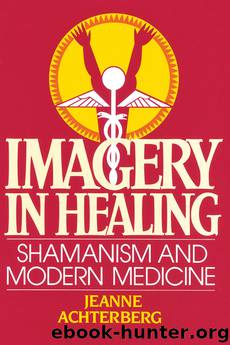Imagery in Healing by Jeanne Achterberg

Author:Jeanne Achterberg
Language: eng
Format: epub
Publisher: Shambhala Publications
4-1
While this seems to be a rather complex process, it is the only way that neurons fire off, with the exception that sometimes the whole business may start up spontaneously, and also that the message from some neurons to their neighbors is ‘‘don’t fire.” (These are called inhibitory neurons, whereas the others are referred to as excitatory neurons, for obvious reasons.)
Either a neuron fires off or it doesn’t—it has what is called an “all or nothing” property. Strong stimulation, or a lot of chemicals bathing its dendrites, doesn’t cause the neuron to fire any differently, only more often. Everything we see, smell, hear—all those images stored up in our memory banks—is based on how many times the neurons fire off, or how many times they don’t, and how many and which ones fire at the same time. It’s a matter of quantity, not quality. Within this amazing biocomputer called the brain, pathways and structures are consistently linked by the transmission of information by the neurons. There is inevitably cross-talk, so all systems have a modulating influence upon each other.
It is the interrelatedness among neurons and their activities that is critical to the assumption that imagery serves as an integrative mechanism between mental and physical processes. The brain areas associated with image storage, when sufficiently activated by thought (such as occurs when vivid, powerful images are created), can theoretically cause enough neurons to fire repeatedly so the message reverberates through the brain. Thus, imaging a tennis serve activates all those muscles involved. Imaging eating a lemon calls into play glandular secretion, swallowing, grimacing.
In future paragraphs, it is important to keep in mind the way the neurons transmit information. Understanding this, the interconnectedness of the structures will make more sense. There is one hitch, though. The human brain stores and processes much more information than is possible with this mechanism alone. We would literally explode if all the neural circuits were as active as would be required for what is normally in our memory banks. We will discuss more on this problem later.
The Representation of the Image: A Proposed Neuroanatomic Model
The cortex
The cerebral cortex consists of multilayers of nerve cells, distributed and distinguished by the recency with which they appeared in evolutionary development. The cortex is made up of two hemispheres connected by a large fiber bundle called the corpus callosum. Cortical areas involved in sensory and motor function of the left side of the body tend to be located on the right side of the cortex, and vice versa. Communication between the two hemispheres is maintained by neurons traversing the corpus collosum, as well as by fibers known as the anterior and posterior commissures, which bridge the thalami.
The right and left hemispheres have developed specialized functions as a consequence of both the evolution of the species and the events of an individual’s own developmental history. Knowledge in this area was significantly bolstered by the work of Sperry and Gazzaniga, Bogen and others who studied the results of the “split- brain” surgical procedures.
Download
This site does not store any files on its server. We only index and link to content provided by other sites. Please contact the content providers to delete copyright contents if any and email us, we'll remove relevant links or contents immediately.
| Acupuncture & Acupressure | Aromatherapy |
| Ayurveda | Chelation |
| Chinese Medicine | Energy Healing |
| Healing | Herbal Remedies |
| Holistic | Homeopathy |
| Hypnotherapy | Massage |
| Meditation | Naturopathy |
| Reference |
Inner Engineering: A Yogi's Guide to Joy by Sadhguru(6455)
The Power of Now: A Guide to Spiritual Enlightenment by Eckhart Tolle(5356)
Fear by Osho(4502)
Ikigai by Héctor García & Francesc Miralles(3909)
The Art of Happiness by The Dalai Lama(3855)
The Ultimate Bodybuilding Cookbook by Kendall Lou Schmidt(3715)
Yoga Therapy by Mark Stephens(3577)
The Little Book of Hygge by Meik Wiking(3453)
Why Buddhism is True by Robert Wright(3294)
The Healing Self by Deepak Chopra(3273)
Being Aware of Being Aware by Rupert Spira(3096)
The Hatha Yoga Pradipika (Translated) by Svatmarama(3087)
Shift into Freedom by Loch Kelly(3035)
Wild Words from Wild Women by Stephens Autumn(2944)
Work Clean by Dan Charnas(2904)
Happiness by Matthieu Ricard(2892)
More Language of Letting Go: 366 New Daily Meditations by Melody Beattie(2862)
Yoga Body & Mind Handbook by Jasmine Tarkeshi(2754)
Why I Am Not a Feminist by Jessa Crispin(2591)
